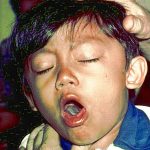 Acute infectious disease usually in children caused by a Bacillus bacterium and accompanied by catarrh of the respiratory passages and repeated bouts of coughing.
Acute infectious disease usually in children caused by a Bacillus bacterium and accompanied by catarrh of the respiratory passages and repeated bouts of coughing.
A respiratory infection caused by Bordetella pertussis and characterized by paroxysmal coughing ending in a prolonged crowing intake of breath.
A bacterial infection especially of the children caused by bacterium Bordetella pertussis marked by convulsive spasmodic coughs.
An infectious disease caused by Bordetella pertussis affecting the bronchial tubes, common in children, and sometimes very serious.
An acute contagious disease, primarily affecting children, due to infection of the mucous membranes lining the air passages by the bacterium Hemophilus pertussis. After an incubation period of 1-2 weeks catarrh, mild fever, coughing, and loss of appetite gradually develop and persist for 1-2 weeks. The cough becomes paroxysmal: series of short coughs are followed by involuntary drawing in of the breath, which produces the whooping sound. Bleeding from the nose and mouth and vomiting often occur after a paroxysm. This stage lasts about two weeks and the child is infectious throughout. Over the following 2-3 weeks symptoms slowly decline but the cough may persist for many weeks. Whooping cough is seldom serious but the child is susceptible to pneumonia and tuberculosis. Immunization reduces the incidence and severity of the disease: the vaccine is usually given in a combined form. An attack usually also confers immunity.
Whooping-cough, or pertussis, is a respiratory tract infection caused by the bacterium Bordetella pertussis and spread by droplets. It may occur at all ages, but around 90 per cent of cases are in children aged under five. Most common during the winter months, it tends to occur in epidemics, with periods of increased prevalence occurring every three to four years. It is a notifiable disease. The routine immunization of infants has drastically reduced the incidence of this potentially dangerous infection. In the 1990s over 90 per cent of children in England had been vaccinated against whooping-cough by their second birthday. In an epidemic of whooping-cough, which extended from the last quarter of 1977 to mid-1979, 102,500 cases of whooping-cough were notified in the United Kingdom, with 36 deaths. This was the biggest outbreak since 1957 and its size was partly attributed to the fall in vaccination acceptance rates because of media reports suggesting that pertussis vaccination was potentially dangerous and ineffective. Currently about 50—100 cases are reported per 100,000 popualtion each year. Cases proven by laboratory diagnosis (which is probably the tip of an iceberg) are about 1000 annually.
Pertussis, a contagious respiratory tract illness, is the result of an infection caused by the bacterium Bordetella pertussis. This particular bacterium is responsible for triggering the onset of the disease, which primarily affects the respiratory system. Pertussis is characterized by its distinctive symptoms, including severe coughing spells, difficulty breathing, and the notorious “whooping” sound that occurs during inhalation after a coughing fit. This infectious disease can be quite concerning due to its ability to spread from person to person through respiratory droplets. It is important to be aware of the symptoms and take appropriate measures to prevent the transmission of pertussis within communities.
A highly infectious acute fever, commonly found in children, characterized by inflammation of the respiratory tract and spasmodic coughing. This cough may or may not be accompanied by the inspiratory laryngeal spasm that creates the distinctive “whoop” sound. This condition is also known as pertussis.
